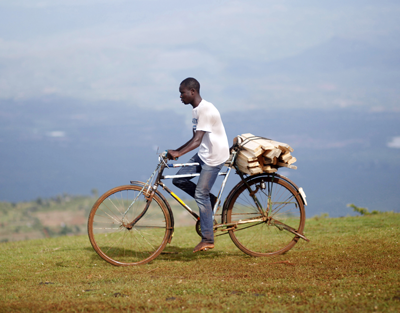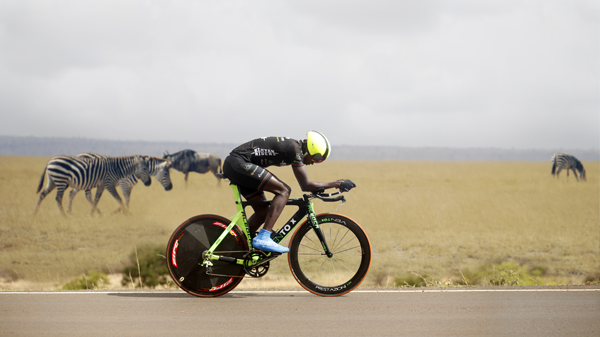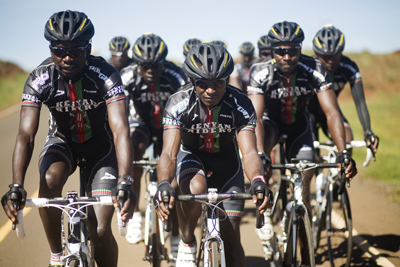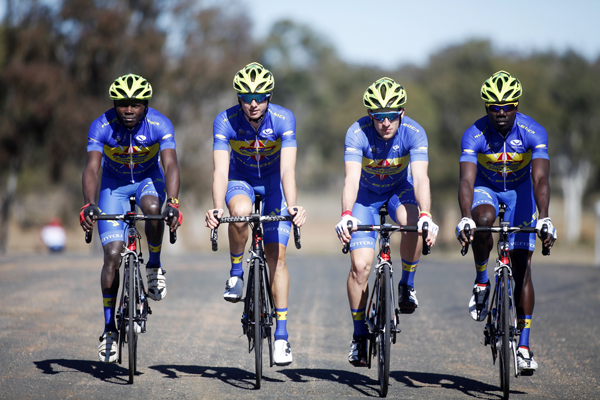Tom McQuillan chats to Team Kenyan Riders Downunder assistant directeur sportif Simon Blake and team founder Nick Leong about this unique pro cycling team.
Among all the teams on the Australian and Asian domestic racing circuits, there are perhaps none as distinctive as Team Kenyan Riders Downunder. The team’s riders come from Kenya, Australia and New Zealand and are now racing at UCI Continental level – the third highest tier in the sport.
How did the idea for the Kenyan Riders project come about?
Nick Leong: I’d been watching the Tour de France since I was a teenager in the 1980s, and was surprised that I’d never seen a black athlete in the Tour. [But I’d seen] Kenyans winning marathons, and I thought to myself that they [might] make very good bike riders if someone gave them the opportunity. I was a commercial development officer who didn’t know a lot about cycling, but in the mid-2000s I just decided to go to Kenya and see if it would work.
What does a path toward bike riding look like for a potential rider from Kenya?
 NL: It’s a generational thing, really. The first generation are the people who used the bike to make a living – carrying wood, milk or passengers. We’re now in the next generation, where we’re getting kids in schools interested in racing bikes by giving out bikes to naturally talented kids or those who already ride bikes to school.
NL: It’s a generational thing, really. The first generation are the people who used the bike to make a living – carrying wood, milk or passengers. We’re now in the next generation, where we’re getting kids in schools interested in racing bikes by giving out bikes to naturally talented kids or those who already ride bikes to school.
From there we give the kids training programs, get them entering Kenyan races and establish cycling scholarships, so that by the time they leave school they might be ready to come into a developmental program and become a professional cyclist.
What made the team interested in establishing a base in Australia?
Simon Blake: We can train really well in Kenya, but one of the reasons there haven’t been many high-level black African cyclists before now is the lack of a culture around bicycle racing. There are a lot of bikes in Kenya, but they’re used for carrying whatever you can tie onto them.
We’ve found in the past that a guy can be super fit, but if he doesn’t know how to race a bike, then he’ll always lose… he’ll miss a breakaway, he’ll be watching the wrong rider and so on.
Having a base in Australia allows us to expose the guys to a lot of racing – I was saying to Nick earlier this year that the most important races for us are the local club criteriums that no one’s watching. Racing lots of club-level events allows the guys to experiment with racing, see what succeeds and what fails, and learn from that experience. Then when the big races come, they’re more efficient and more able to cope with the demands of racing in a peloton.
NL: That’s definitely the reason that we came to Australia and why we decided to merge with Team Downunder, who already existed here and were based on the Gold Coast. We’re now a UCI Continental ranked team, and we have six Kenyans, three Kiwis and three Aussies riding for us. It’s about finding the right blend of talent and experience among the Aussies and Kiwis to help the Kenyans learn race craft.
I imagine there’s a pretty steep learning curve for new riders. Are there any stories to illustrate that transition?
SB: We had four guys here from January through to April, and when they started they were regularly getting spat out the back of local club races. Just before they left they raced a criterium at [Melbourne’s] Essendon Fields where the team got second, fourth and sixth. They were attacking over and over and you could see a lot of the other riders thinking ‘Oh, not again…’ Although we didn’t get the win, I was really proud of that because they were dictating the terms of the race, even if the moves they were initiating weren’t the smartest.
NL: This is our first year racing at the UCI Continental Level, so we’ve raced the Cadel Evans Great Ocean Road Race and the Herald Sun Tour in Australia, as well as the UCI circuit in Asia – we’ve already been to Indonesia twice, and we’re about to leave for the Tour of Qinghai Lake in China. The plan is to accumulate UCI points this year and to expand much more onto the African circuit next year.
SB: I think the best thing that Nick did last year was to get the team registered at the UCI Continental level. Some of our efforts in Kenya were sort of stagnating, but now that the young guys in Kenya can see a clear pathway to a higher level of cycling through our team, they’re summoning up a lot more initiative. These are guys who were better as juniors than Chris Froome, but previously, we didn’t have that clear pathway, and that meant a lot of guys just ended up getting jobs and feeding their families rather than pursuing cycling.
 One of the team’s stated goals is to provide a chance for African athletes who might otherwise be drawn to track and field or marathon running to compete at the highest level in another endurance sport. With that in mind, what’s your team’s approach to the doping scandals that have affected both professional cycling and Kenyan athletics in the past few years?
One of the team’s stated goals is to provide a chance for African athletes who might otherwise be drawn to track and field or marathon running to compete at the highest level in another endurance sport. With that in mind, what’s your team’s approach to the doping scandals that have affected both professional cycling and Kenyan athletics in the past few years?
SB: We’ve been talking for a while now about a way to get our own anti-doping system set up, because we’ve been going to amateur races for a while now and there’s always talk. Ultimately that was one of the reasons for upgrading the team to Continental level, because otherwise you don’t know what you’re up against – at the UCI level there is at least some testing going on. Recently we went to two races in Indonesia – the Tour of Ijen and the Tour of Flores – and a lot of cyclists were quite unhappy that there was testing in Flores but not Ijen a week later. It’s hard to be really thorough in Kenya because the cycling federation doesn’t have a lot of money, but we’d like to do some testing now so that we can establish a baseline level of performance that can be referred to if and when they do reach the highest level.
The UCI’s World Cycling Centre, teams like Dimension Data, and the growing presence of Eritrean riders means that African riders are now more prominent than ever. What has this meant for the African cycling circuit?
NL: The rise of guys like [Eritrean Dimension Data riders] Merhawi Kudus and Daniel Teklehaimanot is really encouraging for us, because we’ve raced against them at the Tour of Rwanda in the past and they’re around the same level as our guys. With equality of opportunity, there’s no reason we can’t compete at that highest level.
SB: The fact we have Eritrean cyclists emailing us and asking if they can join our team is a good indicator of that, because Eritrea is one of the few places in Africa where a culture of bike racing already exists. I think it’s because Eritrea was colonised by Italy way back when – it means they love coffee, pasta and bike racing. If you Google pictures of Eritrean bike racing you can see roads lined with fans.
NL: Rwanda is pretty similar in terms of culture, and they’re starting to establish some structures too. We’ve raced at the Tour of Rwanda a few times and the crowds are absolutely huge – they’re six or ten deep all along the course, and there are loads of kids there who will be inspired to become cyclists because of that.
How does your talent identification process work?
 SB: It’s super loose. With some guys we are starting to set up a process that will hopefully get us results, but more often than not it’s a case of not knowing until you try something. It might be as simple as someone seeing a guy riding down the street and asking them to come along to a training session…
SB: It’s super loose. With some guys we are starting to set up a process that will hopefully get us results, but more often than not it’s a case of not knowing until you try something. It might be as simple as someone seeing a guy riding down the street and asking them to come along to a training session…
NL:…or it might be the younger brother of someone who we already know is good!
SB: At the moment we’re working towards something with [charity] World Bicycle Relief and [bicycle component manufacturer] SRAM, who have given bikes to a number of Kenyan schools that are quite close to where we’re based. Kids there often have to walk long distances to get to school, meaning they either miss out on class time or miss out on time they could be helping at home – doing chores, milking cows, cooking – or they’re missing out on study time.
If World Bicycle Relief can provide these kids with a bike, it means that children can stay in school longer, get a qualification, and have more options in life. Because we’re looking for talent in an area where lots of runners come from and now there are heaps of kids on bikes, it’s a very good thing for the community and for us as well.
NL: The other thing is that we don’t necessarily need to have a large pool of riders to find very good talent. At the beginning I was fixated on very good runners – guys who would have been national champions anywhere but Kenya – but that proved to be very hit and miss. After that we started looking for strong sportsmen who came from the same tribes as most of the elite runners: volleyballers, cross-country runners, soccer players etc.
We generally start out with a pool of about 50 guys and take them to this climb outside Iten, which is the town where the majority of Kenya’s most successful marathon runners come from. Any rider who can complete the climb [which is 9.8km long at an average gradient of 7.3%, climbing to exactly 2,000 metres above sea level] in around 30 minutes is capable of generating around 6 watts per kilo of body mass – pretty similar to a Tour de France rider.
If a Kenyan guy can get that result after around six months of training and riding, then we don’t necessarily need 100,000 people participating. Once we find a rider who can make that 30 minute effort, the next challenge is to transfer that ability into a winning performance in competition. That’s our challenge now.
Earlier this year the team had the chance to race in the Jayco Herald Sun Tour alongside Chris Froome, the most famous cyclist to come from Kenya thus far. Has Froome been a rider your team has looked up to and what was it like to race against him?
NL: I’d say yes – he visited our training camp a couple of years ago!
SB: From what I can see on social media, a lot of Kenyan cyclists still see Froome as Kenyan and are proud of his successes, but outside the small cycling community in Kenya he’s just another white guy who competes in professional sport in Europe. If he was black, it’d be a different story, but at the moment it’s hard for most of the population to connect.
NL: When Froome was a teenager he was riding with David Kinjah [the first black Kenyan cyclist to ride for a European professional team] and a group of his peers and at that point he wasn’t an outstanding talent. The difference is that Froome was able to be educated in South Africa and continue pursuing cycling while a lot of the other guys didn’t have those opportunities. Now that we’re starting to have some impact we’re seeing young black African men turn to cycling because they want to, rather than because anyone is telling them to.
The Kenyan Riders Down Under was the first team worldwide to boast a men’s road race national champion in 2016 when Jason Christie won the New Zealand road race championships on January 10th. What’s your aim for non-African athletes like Jason?
SB: Obviously the focus of the team is to give East African riders opportunities – opportunites which already exist for British, American or Aussie riders. At the same time, there a number of guys on our team who probably wouldn’t be racing at the UCI Continental level if Kenyan Riders Downunder didn’t exist. While we’re learning from the Aussies and Kiwis on our team, we’re also giving them another potential pathway to the top.
How have the non-Africans helped the Kenyan riders adjust to living and racing down under?
NL: They’ve done really well. Jason Christie is often in a position to win stages in smaller races, which helps us secure invites to the bigger races, and the rest of the guys have been really good at teaching the Africans racecraft – things like holding position in the bunch and how to be a good teammate.
SB: The Aussies and Kiwis occasionally also stay in the team house with the Kenyans and just chat about cycling with them, which is really fantastic. They can spend hours talking about equipment, diet, training techniques etc, so even if they’ve heard the same advice before, hearing it from a different person makes it stick that much better.
 You’re just about to head off to China for the Tour of Qinghai Lake – one of the toughest and longest races in all of professional cycling. What are your hopes and expectations for that race and the rest of this racing season?
You’re just about to head off to China for the Tour of Qinghai Lake – one of the toughest and longest races in all of professional cycling. What are your hopes and expectations for that race and the rest of this racing season?
SB: In the first few stages we’re probably going to suss out the competition and see what our options are to take a stage win – to be honest, I’ll be happy if we can just be in the mix in the finale most days. It won’t be the case where we must get a stage win or everyone’s unhappy, because we’re still realistic about where we’re at right now.
NL: The race is held at high altitude and is very hilly in parts, so that will suit our Kenyan guys well, seeing as they’ve been born at around 2,000m altitude and have lived there most of their lives.
SB: The Kenyans going to Qinghai Lake are back home now, getting ready to take on the Great Rift Valley Challenge. It’s a 100km race that’s extremely hilly, and is the second biggest race on the Kenyan calendar – everyone who’s anyone in Kenyan cycling will be there and will be trying to beat our four riders. We’re hoping for a good result there.
The goal of the team was originally to provide a pathway for Kenyan riders to the Tour de France. Is this still the stated aim of the team, and do you have a timeline that you’re aiming for?
NL: The timeline really depends on whether we can get a sponsor on board, because having a naming rights sponsor would really accelerate the process. The aim to get to the Tour de France is still there, but it looks likely that our goal will need to evolve so that we become a team based out of eastern Africa rather than Kenya specifically – we’re looking at expanding our reach to take in riders from Uganda, Eritrea, Tanzania and Rwanda.
Looking into the future of the sport, what do you want the legacy of the Kenyan Riders Downunder team to be?
NL: I think what we can contribute is a new narrative to cycling. Most cycling fans will know who Team Sky are, but the rest of the public probably don’t know them as well as they knew the US Postal Service team when Lance Armstrong was riding. What’s more, it’s hard trying to tell a story in cycling that Armstrong hasn’t already covered. We hear Sky saying they’re the fastest because they have the best bikes and best scientists, [but] we tend not to believe them because they’re saying the same thing Lance did, and because he was lying we assume modern teams are lying too.
SB: The story of cycling in the old days was the realm of tough working men who didn’t have a lot of opportunities in life. Through their hard work and their labour in cycling, a rider could make their way to the Tour de France, earn a living wage and potentially give themselves a way out of poverty. If you look at the Tour de France these days, the amount of money involved is outrageous – a rider’s bike can cost about $20,000, and that’s not including their helmet, sunglasses, kit etc. The question we’re asking is: does it need to be that way, or can it go back to something simpler?
NL: I like to think of the Tour de France as a book that’s constantly being written and updated. If we could have our own page in that book in future, I think that’d be a pretty good legacy.
Ride On content is editorially independent, but is supported financially by members of Bicycle Network. If you enjoy our articles and want to support the future publication of high-quality content, please consider helping out by becoming a member.


How do one join the club??